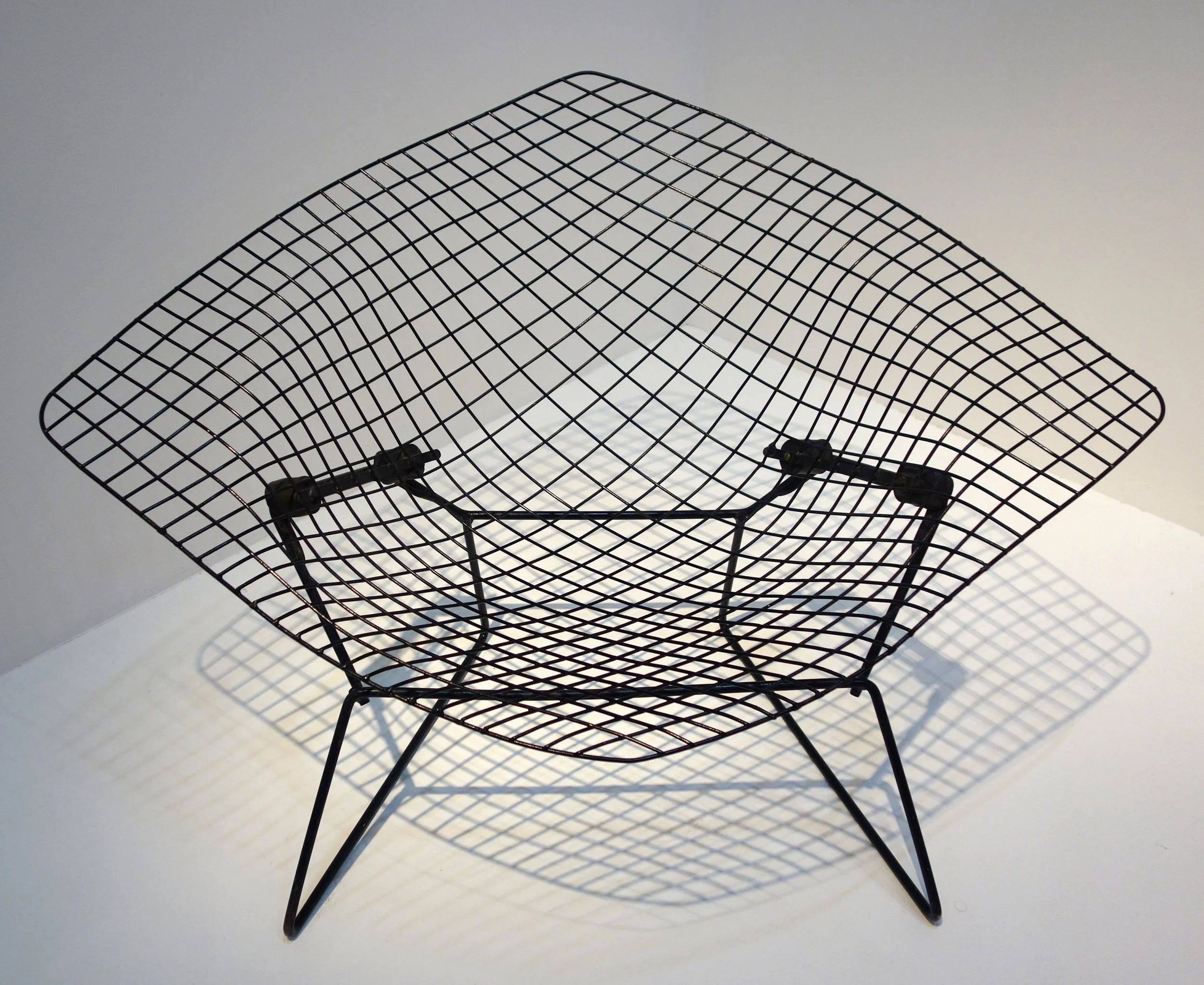Mid-Century Modern Furniture and Design in Michigan
In the mid-20th century, Michigan emerged as an epicenter of modern design, where industry and art intersected. The state’s prosperous manufacturing base – from automobiles to furniture – attracted visionary designers who revolutionized American offices and homes with new looks and materials. Michigan furniture companies didn’t just build chairs and desks; they set trends that defined modern living and working spaces. Meanwhile, Michigan-based architects like Eero Saarinen and Minoru Yamasaki helped define the era’s aesthetic through bold buildings and planning concepts. This overview highlights Michigan’s broad mid-century modern legacy, including its key designers, iconic furniture, influential companies, and landmark architecture.
Key Designers Associated with Michigan’s Mid-Century Modern Movement
Charles and Ray Eames
Ray and Charles Eames
Charles Eames (a Michigan transplant via Cranbrook Academy of Art) and Ray Eames became legendary mid-century designers. The husband-and-wife team met at Bloomfield Hills’ Cranbrook Academy and began experimenting with molded plywood techniques there in the early 1940s. Their efforts were interrupted by World War II, but the Eameses designed a revolutionary molded plywood splint for the U.S. Navy – a project that laid the groundwork for their later furniture innovations. After the war, working with Michigan’s Herman Miller furniture company, they created icons like the Eames Molded Plywood Chair (1946) and the luxurious Eames Lounge Chair and Ottoman (1956). The Eameses emphasized functional, problem-solving design – believing that “what works good is better than what looks good, because what works good lasts”. With their sleek, organic forms and use of new materials, Charles and Ray Eames’ designs became emblems of modern American style and remain coveted pieces of furniture history
Florence Knoll (Schust)
Florence Knoll
A Michigan native, Florence Knoll Bassett (née Schust) was a pivotal figure who shaped mid-century interiors. She studied architecture at Cranbrook and collaborated with contemporaries like Eero Saarinen and Charles Eames during her time there. In 1941 she moved to New York and co-founded Knoll Associates with her husband Hans Knoll, but her Michigan education deeply informed her approach. Florence Knoll was a proponent of the total design of a space – often referred to as the “Knoll Look” – which blended architecture, furniture, and textiles into a cohesive modern environment. She personally designed sleek, functional furniture (like minimalist sofas, tables, and storage units) and also commissioned cutting-edge pieces from other designers for Knoll’s product line. In the 1950s, her vision revolutionized American offices, replacing the heavy, ornate décor of previous eras with open layouts and clean-lined furnishings optimized for how people actually worked. Thanks to Florence Knoll’s influence, corporate and institutional interiors across Michigan (and the country) embraced a refined, functional modernism.
Eero Saarinen
Eero Saarinen
Eero Saarinen – son of Cranbrook’s Finnish-American campus architect Eliel Saarinen – grew up immersed in design in Michigan. He attended Cranbrook himself and later achieved fame as both an architect and a furniture designer. Saarinen’s furniture work for Knoll produced some of the era’s most futuristic pieces. Notably, his Pedestal Collection (1955–56), including the famous Tulip Chair, was Saarinen’s attempt to “clear up the slum of legs” beneath tables and chairs. The Tulip Chair’s single stem-like base and sculptural molded fiberglass seat exemplified space-age elegance and won Saarinen international acclaim. In architecture, Saarinen also left a Michigan legacy with projects like the GM Tech Center. His ability to blend bold structural forms with modern materials carried across disciplines. Whether in a sweeping concrete roof or a sleek fiberglass chair, Eero Saarinen’s work embodied mid-century optimism and innovation.
Harry Bertoia
Harry Bertoia
Harry Bertoia came to Michigan by way of Cranbrook Academy as well, arriving in 1937 as a metalsmith and sculptor. His artistic background led to one of the most distinctive mid-century furniture designs: the Bertoia “Diamond” Chair (1952). Bertoia’s chair is composed of a lattice of welded steel rods, creating an organic bucket form that the designer famously described as “mainly made of air, like sculpture. Space passes right through them.”
This airy wire form, produced by Knoll, was both visually striking and surprisingly comfortable with a removable seat cushion. The Diamond Chair became an instant commercial success, allowing Bertoia to devote himself largely to sculpture thereafter. Beyond the Diamond Chair, Bertoia also created other wire seating and is renowned for his sound sculpture work. His contributions demonstrate how Michigan’s mid-century design ethos blurred the lines between fine art and functional furniture.
(Other notable figures tied to Michigan include George Nelson, Herman Miller’s design director who recruited talents like the Eameses and Bertoia, and Alexander Girard, who led Herman Miller’s textile division. Together, these designers formed a creative network centered in Michigan that profoundly influenced modern design.)
Iconic Mid-Century Furniture Pieces from Michigan
Eames Lounge Chair by Charles and Ray Eames
The Eames Lounge Chair and Ottoman (1956), designed by Charles and Ray Eames for Michigan-based Herman Miller, is one of the world’s most recognizable modern furniture pieces. This luxurious lounge chair – with its molded plywood shell and rich leather cushions – was conceived as a contemporary twist on the English club chair. Introduced by Herman Miller in 1956 and manufactured in Zeeland, Michigan, the Eames Lounge Chair (Model 670) and matching ottoman became an instant classic. Its blend of comfort and elegant simplicity exemplified the mid-century ideal that high design could enhance everyday life. The chair has remained in continuous production since its debut, a testament to its enduring appeal
The Diamond Chair by Harry Bertoia
The Diamond Chair (1952), designed by Harry Bertoia for Knoll, exemplifies the sculptural approach to mid-century seating. Made of bent steel lattice, the chair’s form is at once transparent and sculptural, appearing to float in space. Bertoia’s design was praised for its innovative use of industrial materials – it turns cold steel into an inviting, organic shape. The Diamond Chair was an immediate hit and became a staple of stylish interiors in Michigan and beyond. Its success also underscored Michigan’s role as a nexus for cutting-edge design collaborations (Bertoia developed the chair after his time at Cranbrook, and Knoll produced it while Florence Knoll directed the company’s design ethos).
Eero Saarinen’s Tulip Chair
Beyond these two icons, Michigan’s mid-century scene produced many other influential pieces. Eero Saarinen’s Tulip Chair (and its sibling Tulip dining table), created at Knoll in 1955–56, introduced a sleek one-legged silhouette that is now a classic of industrial design. Herman Miller, under design director George Nelson, released myriad modern furnishings: the Marshmallow Sofa (1956) with its playful series of circular cushions, the angular Coconut Chair (1955), and the biomorphic Noguchi Coffee Table (1947) designed by Isamu Noguchi, among others. Herman Miller also pioneered office furniture with Nelson’s Executive Office Group and, a bit later, Robert Propst’s Action Office system (the precursor to the office cubicle) in the 1960s. Collectively, these pieces – often manufactured in West Michigan – helped define the “Mid-Century Modern” look: clean lines, organic shapes, novel materials, and an integration of form and function. Many are now in museum collections, reflecting Michigan’s outsized influence on 20th-century furniture design.
Major Michigan Furniture and Design Companies
Herman Miller (Zeeland, MI)
Marshmallow Sofa by Irving Harper for Herman Miller
Michigan’s most celebrated mid-century furniture company is Herman Miller Inc., headquartered in Zeeland (near Grand Rapids). Originally a traditional furniture maker, Herman Miller was transformed in the 1930s–40s by visionary leadership and design talent. Founder D.J. De Pree first hired designer Gilbert Rohde in 1930 to develop “the new look” for furniture, pivoting the company away from historical revival styles toward crisp modern lines. Rohde’s early modern designs (unveiled at the 1933 Chicago World’s Fair) were met with enthusiasm, and soon other manufacturers followed his lead. By the mid-1940s, Herman Miller had fully shed its traditional furniture business to focus on modern design. In 1945, De Pree appointed George Nelson as Director of Design – a move that would cement Herman Miller’s identity as a leader in avant-garde furniture. Nelson, in turn, brought in collaborators like Charles and Ray Eames, Alexander Girard, and Isamu Noguchi, giving them a platform to develop what would become modern classics. Under Nelson’s guidance, Herman Miller produced an extraordinary range of iconic pieces (many mentioned above) that embodied mid-century ideals. By the 1950s, “Herman Miller had become synonymous with ‘modern’ furniture”, and the company’s West Michigan facilities were busy turning out designs that furnished homes and offices nationwide. Herman Miller also pioneered the concept of the modern furniture showroom – it opened the nation’s first all-modern, standalone furniture showroom in Chicago in 1939, and a striking Nelson-designed showroom in Grand Rapids in 1948. Today Herman Miller (now part of MillerKnoll) remains a global design leader, a legacy built on its mid-century breakthroughs.
Herman Miller acquires Knoll on July 19, 2021 to form MillerKnoll, Headquartered in Grand Rapids, Michigan.
Steelcase (Grand Rapids, MI)
Grand Rapids – long nicknamed “Furniture City” – was home to Steelcase, Inc., another pillar of Michigan’s design heritage. Founded in 1912 as the Metal Office Furniture Company, Steelcase initially made fireproof metal safes, file cabinets, and wastebaskets. (In fact, its first patented product in 1914, the sheet-metal “Victor” wastebasket, became popular for its ability to prevent fires in an era of in-office smoking.) As the name implies, Steelcase specialized in steel furnishings – promoting them as a modern, durable alternative to wood. By the 1930s, the company was a leading producer of metal desks and had caught the attention of architect Frank Lloyd Wright. In 1937, Steelcase collaborated with Wright to engineer and produce the streamlined office furniture for the Johnson Wax Headquarters in Racine, WI, resulting in some of the first modern workstations. (Wright’s radical curved desks and three-legged chairs for that project were built with Steelcase’s input.) Throughout the 1940s–50s, Steelcase continued to innovate in office furniture. Notably, in 1946 it introduced a modular steel desk system based on 15-inch units, allowing flexible space planning in open offices – a concept that set a new industry standard for the postwar workplace. By the mid-century, Steelcase was synonymous with high-quality, functional office interiors, outfitting corporate offices, schools, and institutions across Michigan and the U.S. with its tables, desks, and seating. Steelcase grew to become (and remains) one of the world’s largest office furniture manufacturers. The company’s success story highlights how West Michigan led the nation in transitioning work environments to the modern era – with Steelcase focusing on workplace design as Herman Miller did in the home and later office, and Haworth Inc. (founded in Holland, MI in 1948) joining the mix as another major office furniture maker. Together, these Michigan companies formed the backbone of America’s mid-century furniture industry, marrying the state’s manufacturing prowess with forward-thinking design.
(It’s worth noting that Knoll, though headquartered in New York, had deep Michigan connections through Cranbrook and designers like Florence Knoll and Eero Saarinen. Many Knoll pieces – from Saarinen’s Tulip collection to Bertoia’s wire chairs – were conceived by Cranbrook alumni, underscoring Michigan’s role as an incubator for modern design talent.)
Michigan’s mid-century modern legacy showcases a unique blend of creativity, innovation, and craftsmanship. Visionary designers such as Charles and Ray Eames, Florence Knoll, Eero Saarinen, and Harry Bertoia transformed everyday furniture, leaving a lasting mark on both home and office interiors. Companies like Herman Miller and Steelcase were central to this movement, producing timeless pieces still valued today.
At the Sam Beauford Woodworking Institute (SBWI), we provide courses that thoughtfully explore Mid-Century Modern Furniture. Our classes are designed to help students appreciate the style's philosophy and master traditional woodworking techniques associated with this influential era. Whether you're interested in recreating classic designs or developing your own projects inspired by mid-century principles, SBWI offers a supportive environment for learners at all levels. We invite you to join us in continuing Michigan’s legacy of fine craftsmanship and thoughtful design.
Click Here to see Course Offerings
Sources:








